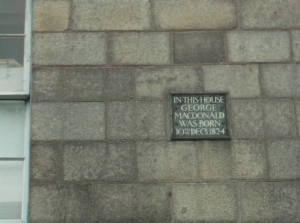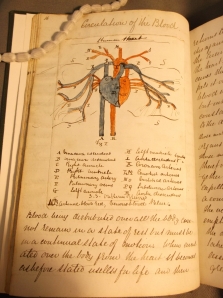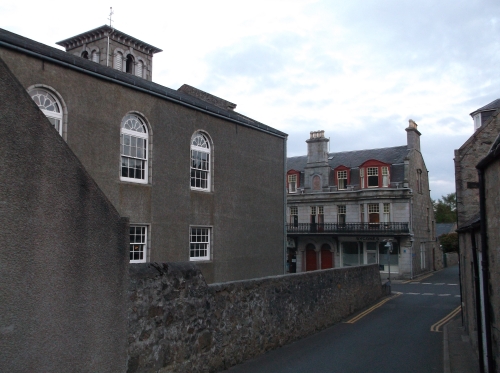While almost everybody on the academic home shores of Oxford was following the Summer VIIIs last week , I ventured to far-away Scotland to retrace the footsteps of Aberdeenshire author George MacDonald (1824-1905), subject of my current thesis chapter.
Huntly, Aberdeenshire
I began my journey in Huntly, the birth place of the author, which seems very quietly, but charmingly haunted by the presence of the author. While a small almost unnoticeable plaque over the bright sign of a dental practice points out the place of the author’s birth, no statue commemorates the town’s son. However, it is his words that greet the visitor – “Welcome to Huntly – Room to Roam” – a quote from his first major work of literary fantasy, Phantastes (1858), which, many argued crucially influenced his close friend Lewis Carroll’s Alice’s Adventures in Wonderland (1865) (some are sceptical, but both dreamers definitely follow a white rabbit at an early stage of their journey).
Thou goest thine, and I go mine
Many ways we wend;
Many days, and many ways,
Ending in one end.Many a wrong, and its curing song;
Many a road, and many an inn;
Room to roam, but only one home
For all the world to win.
The poem sung by the ideal woman, the novel’s protagonist is chasing, but who continuously escapes his grasp.
Huntly, or Milton of Strathbogie, as it was formerly known, is situated (you guessed it) at the river Bogie, whose lush green banks don’t leave much to the imagination, when one rethinks the journey through green woodlands, along a river which leads Anodos into Fairyland in the novel.
On the way back from the river one passes the house Howglen and recalls his later novel Alec Forbes of Howglen (1865). The house belonged to the Rev Robert Troup, whose daughter Sophie was blind, hence why the house’s name is also displayed in Braille.
Back in the town square, the banks in front of Brander Library display the famous epitaph from David Elginbrod (1863).
Overall, it was however sad to see that the MacDonald estate had been moved from the local library into various different archives, where it is now being kept in boxes. And despite the re-branding of Huntly, and the omnipresence of the “Room to Roam” slogan (on every single bin in town), even “MacDonald-Street” runs the risk of going unnoticed – or rather unassociated with the son of the family after which it is named, whose former school is just located at its end.
Aberdeen
MacDonald studied the sciences at King’s College Aberdeen, which was the main reason for my visit. From the local pub – the Gordon Arms – MacDonald would have taken the horse cab to depart to Aberdeen – possibly down what is now the A96 – I took the same route in a slightly faster cab.
I learned that Aberdeen University Library looks a bit like a spaceship (from the inside), that the rest of Aberdeen is mainly made of Granite, which is a) cool and sparkly when sunny, but b) a bit too grey when not sunny. I also learned that the two colleges (Marischal and King’s) were thriving centres for the study of the Natural Sciences and Medicine in MacDonald’s student days, and the medical heritage of the University of Aberdeen (which was the result of merging the two colleges) is omnipresent in the old town. But mainly, I was amazed by how much more impressive the lecture notes of those courses looked, which were taken and archived for posterity by students, then anything I will ever hand down myself (or possibly not). One of the note-taking students, whose name in the cover of the notebook was indicated as “A. Bain” , was in fact the philosopher and psychologist Alexander Bain, who went on to found the journal Mind.
, was in fact the philosopher and psychologist Alexander Bain, who went on to found the journal Mind.
MacDonald’s handwriting was thankfully on the more legible end, and I got the chance to view his letters and manuscripts of, amongst others, At the Back of the North Wind (1871) , the story of the sickly boy Diamond, who is taken on a fantastical journey by the beautiful North Wind.
Mintlaw & Oldmeldrum
The Aberdeenshire Museum and Library headquarters hold more of MacDonald’s manuscripts, including Within and Without (1855), The Princess and the Goblin (1872), that was first called “The little Princess and the Goblin”) and David Elginbrod (1863) in which’ Herr von Funkelstein” was originally called ‘Count Halkan’. What is more, in addition to Oldmeldrum’s rare foreign language editions of his works, Mintlaw keep sketchbooks, photoalbums and, most amazingly, stage props from the Pilgrim’s Progress play the MacDonald family performed in. Indeed, some sketches folded to 8 times their size turned out to be the sketches for the stage curtains for said performance, and will hopefully one day find their way out of archive shelves into display cabinets.
There and Back; in Huntly
Returning to MacDonald’s hometown it is not hard to see the influences his Scottish home and university towns had upon his fiction. While I gained this insight, following the footsteps of MacDonald, David Elginbrod and Anodos, I also had the chance to admire the beautiful natural surroundings of the Scottish Highlands. In a strange way, MacDonald’s writings only seem to reveal their real nature when put back into the context of their place of creation. And if Scotland is currently not exactly on your doorsetp, I hope you enjoyed this blog, otherwise, go dust off that old mirror in your attic, or go to sleep. You never know where you’re going to wake up…












Lovely! Best trip I’ve ever taken was there to see GM’s old stomping grounds. Thanks for the Blog!
Dan
My wife and I are planning a visit in May 2015 to Huntly, and other GM related places of interest. Any other recommended sites or locations?
Great post! I truly enjoyed the journey! I visited Scotland some years ago, but missed out on Huntly and a few other places. Hope to return one day and pick up where I left off.
I knew Huntly well as a child, as my aunt was married to a descendent of Rev Robert Troup. I stayed at Howglen often. The Princess and Curdie, and The Princess and the Goblin, were amongst my favourite childhood books. Thank you for your article; a real trip down memory lane for me.
That’s wonderful! I’m so glad you enjoyed the post!
Reblogged this on George MacDonald's Scotland.
I recently went to see his grave in Italy. I hope to go here soon! Thanks for the post I want to track down all of these places! He is my favorite writer!
I am a George MacDonald fan and have been since discovering his novels back in the 90’s which were my 30’s. I am planning a trip to Scotland with my husband so I can see where my mentor grew up and developed his mind, thoughts and ideas about God. I thought for sure I could find a local Scotsman who could take us on a day trip dedicated to the life of GM but no luck so far
Is there anyone you found?